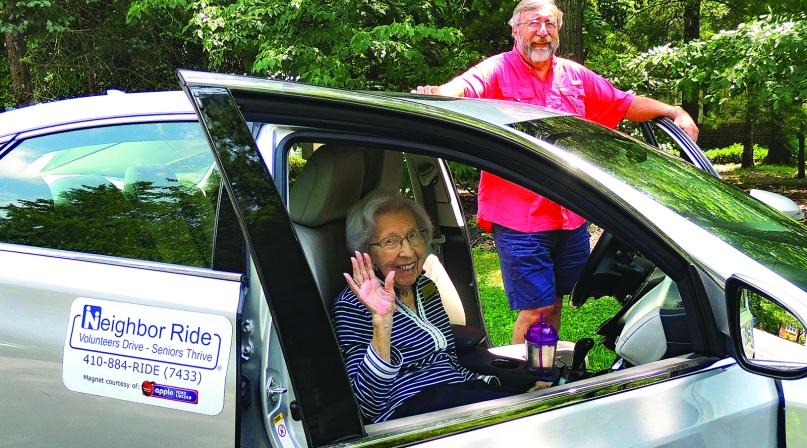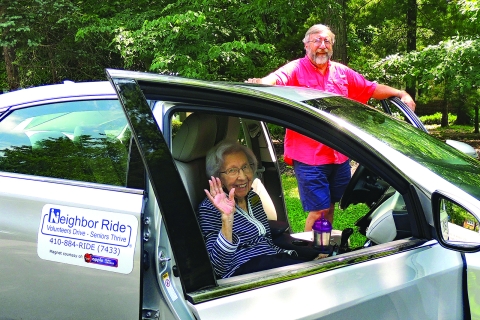Counties provide transportation alternatives for older adults
Author
Upcoming Events
Related News

With the number of Americans 65 and older projected to nearly double by 2060, counties are facing challenges in providing services to meet the transportation needs of this growing demographic. Counties are working to establish programs and services to fill the needs of older individuals who often struggle when they can no longer get behind the wheel because of physical and mental disabilities. Older adults face difficulties finding transportation alternatives, which may lead to loneliness and social isolation especially for those with few transit options where they live.
Mobility managers
The Department of Transportation defines mobility management as an approach to deliver coordinated transportation services to customers including older adults, people with disabilities and individuals with lower incomes.
In Montgomery County, Md., Transportation and Mobility Manager Shawn Brennan said she works to promote transportation options, improve and expand services and tap into the county’s transportation options to help older adults.
In Montgomery County, most older adults want to drive for as long as possible and do not want to explore alternative options, Brennan said. For individuals who have lived their whole lives without using a bus and then need to stop driving for medical reasons, it is often difficult to learn how to use public transportation.
Brennan said she advocates for older adults and stays connected to those who use different programs to listen to their needs and create a transportation system that is easy to navigate.
With Montgomery County offering a variety of programs including a public transit system, taxi system, volunteer programs, escorted transportation and a paratransit system, Brennan said it is difficult for older adults to be informed about each program.
“That’s part of what mobility management is about — being clear on what all the players are doing, having an understanding of whose needs will be met through the various programs and helping to direct them,” she said.
Mobility management is different depending on the setting, she said.
In some communities, mobility managers have to create services if there are none and in other areas, the job focuses on helping people use existing programs.
“I am doing things that hopefully are improving the whole mobility picture for older generations and people with disabilities,” she said.
In Dane County, Wis., the Dane County Transportation Department is managed by a certified mobility manager who oversees 18 diversified transportation programs. Jane Betzig is the transportation coordinator, an equivalent position to a mobility manager.
“A mobility manager has the goal of getting them [older adults] where they want to go regardless of what it takes to get them there,” Betzig said.
Volunteer programs
Neighbor Ride, a volunteer program in Howard County, Md., has grown from 20 volunteers in 2004 to 400 volunteers who provide 1,500 trips per month and fill 96 percent of ride requests.
Neighbor Ride’s Community Outreach Coordinator Colleen Konstanzer said the program originated from a 2001 Office of Aging study that projected a rapid population growth of the aging population. Transportation was one of the top concerns for older adults.
The Neighbor Ride service is available to Howard County residents who are over the age of 60 and can navigate on their own to a volunteer driver’s car.
Older adults can call the Neighbor Ride office or visit the website to request a ride three business days in advance. Ride requests enter an online system where individuals or their adult children can log on to request rides, check the status of rides or make payments.
When a client calls, ride coordinators find available drivers. Clients choose their destination and volunteer drivers typically take them round trip. Konstanzer said half of the ride requests are medical-related, but others include trips to get haircuts, go shopping or see friends.
The service provides up to 12 round trips per month.
“That’s the way to make sure we’re available to everyone and not just serving a very small set of clients with huge, huge transportation needs,” Neighbor Ride Executive Director Bruce Fulton said.
Each volunteer receives a criminal background check and a driving background check.
“That’s so wonderful about the model, too, I mean driving — everyone can inherently do,” Fulton said. “There’s no special skillset or set of aptitudes or qualifications that you need to have.”
Neighbor Ride uses a “good neighbor” fund and does not have fees for clients whose income is 120 percent of the federal poverty level, Fulton said. For other clients, there are fees for the service based on mileage.
Through the Neighbor Ride service, Fulton said clients form relationships with volunteers. He said many older adults find comfort in knowing a few days early that their trip is covered.
“The population knows what they want to do and we’re just enabling them with the transportation piece to do that, using volunteers which is kind of an engaging experience,” Fulton said.
Brennan said in Montgomery County, she hears the fewest complaints about volunteer transportation programs. Montgomery County has a volunteer program called Senior Connection which also creates social connections between older adults and volunteer drivers.
“When people can’t drive anymore…their next best thing is to just slide over and be in the passenger seat,” she said.
Call centers
The Dane County Transportation Department established a call center in 2008 as a one-stop shop for transportation information for older adults and people with disabilities.
The call center operates using funding from a grant which supports its operations, two travel training programs and a full-time mobility manager, which is Betzig’s role in the community.
The call center offers information on all available transportation options including public transit, human services programs and volunteer driver programs.
Many of the human services programs specifically help transport the elderly and people with disabilities, but the center also serves Dane County workers, refugees, low-income families, individuals experiencing homelessness and veterans, Betzig said.
The center directs individuals to transportation options tailored to their needs and answers questions about transportation, sets up rides and provides callers with available options.
“The whole purpose is to give them very personalized attention so that not only are their questions answered, they also now leave with options about different transportation opportunities,” Betzig said.
The call center is also familiar with public transit that’s available to match individuals with programs such as shared-ride taxis.
“It can be very overwhelming especially for the elderly,” Betzig said.
“They don’t know where to even begin to get help for any form of transportation.”
The call center dispatches 48,000 rides per year not including rides through diversified programs such as the Retired and Senior Volunteer (RSVP) Driver Escort Program, which is funded by the county and involves ride coordinators and volunteer drivers providing a door-to-door service to older adults.
Montgomery County has a similar call center called the Connect-A-Ride program where individuals and family members can explain their situation over the phone and have their transportation needs matched to available programs.
“Having one place to send them is really great,” Brennan said.
“We really want to have the whole gamut of transportation needs available to help someone,” Betzig added.

Attachments
Related News

U.S. House of Representatives passes SPEED Act and other permitting reform bills
On December 18, the U.S. House of Representatives passed the SPEED Act (H.R. 4776). The SPEED Act would strengthen county involvement in decision-making and make needed commonsense reforms to the federal environmental review process.

Counties and Railroads: Shared Priorities for the Next Surface Transportation Bill
County leaders from across the country have a vital opportunity to ensure their infrastructure priorities are front and center.

House lawmakers introduce bipartisan legislation to support World Cup local transportation needs
On December 2, U.S. Reps. Rick Larsen (D-Wash.-02) and Burgess Owens (R-Utah-04) introduced the Transportation Assistance for Olympic and World Cup Cities Act (H.R.6348), a bipartisan effort to strengthen local transportation systems in communities preparing to host major international sporting events
